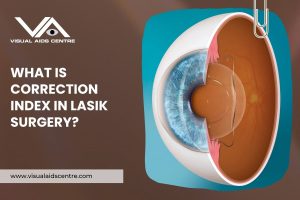Table of Contents
ToggleMild eye discomfort one month after LASIK is uncommon but can occur for several reasons.
If you’re experiencing persistent pain, it’s essential to address the concern immediately to ensure proper healing and avoid complications.
LASIK (Laser-Assisted in Situ Keratomileusis) revolutionised vision correction, offering freedom from glasses and contact lenses to millions worldwide. While the procedure is typically safe and effective, post-surgery complications, though rare, are a possibility. Discomfort or pain should not be ignored, as it may point to an underlying issue requiring medical attention. Here’s a detailed breakdown of what could be causing your discomfort and what you can do about it.

Common Causes of Eye Pain One Month After LASIK
1. Dry Eye Syndrome
One of the leading causes of post-LASIK eye discomfort is dry eyes. During LASIK surgery, nerves in the cornea are severed to reshape its curvature, which impacts the production of tears. While most patients experience improvement within weeks, some may continue feeling dryness and sensitivity for longer.
Symptoms of LASIK-induced dry eye include:
- Burning or stinging sensations.
- A persistent, gritty sensation, as if something is stuck in your eye.
- Blurred or fluctuating vision caused by too few tears.
What to do:
- Utilise preservative-free artificial tears regularly to maintain optimal eye hydration.
- Follow your ophthalmologist’s prescribed care plan, which may include punctal plugs or medicated eye drops.
- Avoid environments with dry air, such as air-conditioned spaces, or use a humidifier at home.
2. Corneal Flap Complications
LASIK involves creating a corneal flap that is folded back during surgery. If the flap doesn’t heal correctly or gets dislodged, it could lead to pain or other visual disturbances even weeks later.
Signs of corneal flap issues:
- Sharp, localised pain in one eye.
- Extreme light sensitivity.
- Decreased visual clarity.
What to do:
- Avoid rubbing your eyes—this could worsen flap displacement.
- Consult your surgeon promptly if you suspect flap complications. Early intervention can prevent further damage or infection.
3. Inflammation or Infection
Post-surgical inflammation, called Diffuse Lamellar Keratitis (DLK) or “sands of the Sahara,” can appear days to weeks after the procedure. While rare, untreated inflammation may impair corneal healing, causing ongoing pain.
Potential symptoms of inflammation/infection:
- Persistent redness or swelling.
- Discomfort that doesn’t subside with over-the-counter medications.
- A noticeable decrease in vision.
What to do:
- Apply prescribed anti-inflammatory and antibiotic drops as instructed.
- Seek immediate medical advice if symptoms worsen, as untreated infections can lead to severe complications.
4. Epithelial Ingrowth
Epithelial cells, or surface cells of the cornea, can occasionally grow underneath the LASIK flap during the healing process. While common in the early weeks, they may continue proliferating and cause irritation, requiring attention.
Possible signs:
- Persistent discomfort similar to a foreign object in the eye.
- Visual distortions or blurring.
What to do:
- If epithelial ingrowth is significant, it will need surgical removal. Speak with your ophthalmologist for tailored treatment options.
5. Underlying Conditions
Not all pain after LASIK is directly related to the procedure itself. Existing eye conditions may resurface or worsen post-surgery, contributing to pain and discomfort. These conditions include:
- Corneal abrasions or micro-tears resulting from trauma.
- Ocular surface diseases, such as Meibomian gland dysfunction.
- Sinus pressure that might feel like eye pain.
What to do:
- Share a complete medical history with your eye doctor so they can pinpoint the issue.
- Regular follow-ups post-LASIK are critical for identifying any underlying conditions early.
Other Contributing Factors
1. Staring at Screens or Digital Eye Strain
Modern lifestyles demand long hours in front of digital screens, which can exacerbate eye strain and dryness after LASIK. Reduced blinking while looking at screens aggravates discomfort.
Tips to Reduce Digital Strain:
- Follow the 20-20-20 rule—every 20 minutes, look at something 20 feet away for 20 seconds.
- Adjust your screen brightness to match your environment.
- Use lubricating eye drops when working at a computer.
2. Incorrect Post-Operative Care
Not following post-op care guidelines meticulously can delay healing or introduce complications. For instance:
- Forgetting your prescribed eye drops can increase dryness.
- Squinting or rubbing your eyes could interfere with corneal healing.
Ensure proper follow-up care by:
- Wearing protective goggles or glasses as advised.
- Keeping your scheduled appointments with your LASIK surgeon.
When Should You See a Doctor?
While occasional mild discomfort is not unusual, the following symptoms warrant immediate medical attention:
- Prolonged pain lasting more than an hour without relief.
- Severe redness or swelling.
- A sudden drop in visual acuity.
- Sensitivity to light combined with blurry vision or halos.
Do not delay reaching out to your ophthalmologist. They are equipped to identify whether the symptoms are part of the normal healing process or a sign of complications.
Can Eye Pain 1 Month After LASIK Be Prevented?
Although some discomfort may be unavoidable due to individual healing patterns, you can reduce the risk by following these tips:
- Stick to your post-op medication plan: Anti-inflammatory eye drops minimise discomfort.
- Take breaks from close work or reading to rest your eyes.
- Wear UV-protective sunglasses outdoors, as sunlight can exacerbate sensitivity.
- Avoid contact sports or activities where an impact on your eye is likely during the first three months.
Final Thoughts
LASIK is a life-changing procedure, but the healing process varies for everyone. Pain one-month post-surgery is not typical and could signal an issue requiring medical treatment. Timely intervention can prevent complications and promote complete healing.
If you’re unsure about any symptoms or need reassurance regarding your recovery, your LASIK surgeon is your best resource. Regular check-ups and open communication are key to achieving long-term eye health and visual clarity.
Remember: Your eyes deserve the utmost care—they’re irreplaceable. Don’t hesitate to consult your doctor and ensure your recovery is on the right track!













